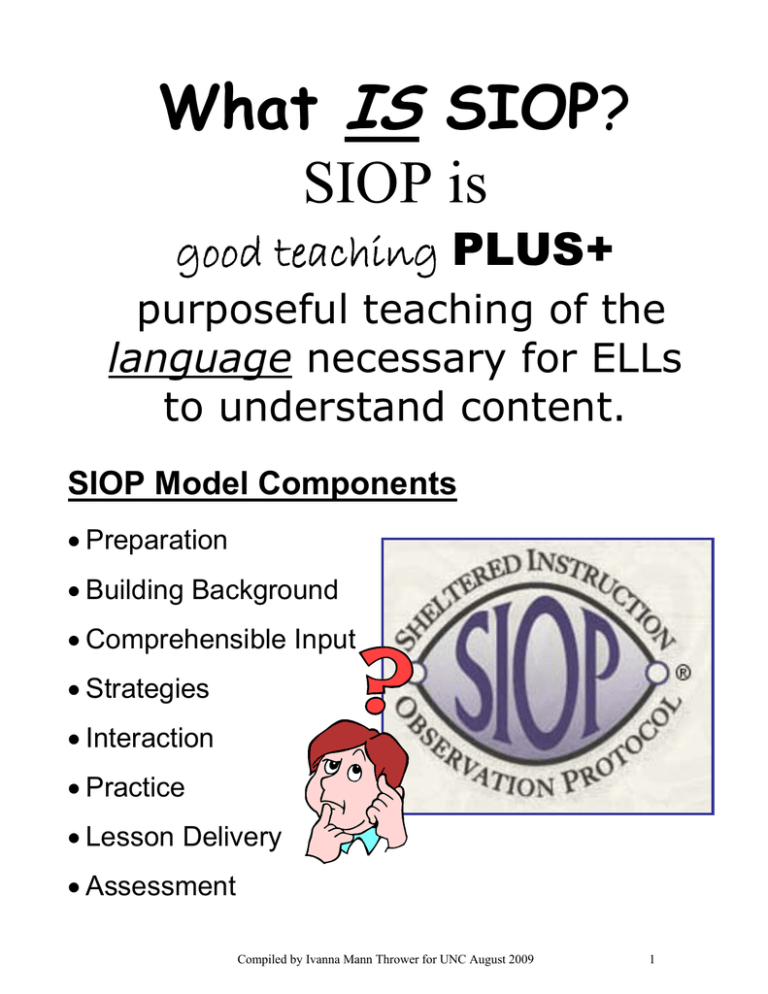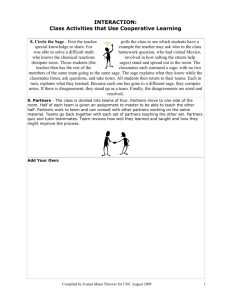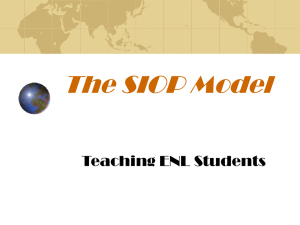What IS SIOP? SIOP is - UNC School of Education
advertisement

What IS SIOP? SIOP is good teaching PLUS+ purposeful teaching of the language necessary for ELLs to understand content. SIOP Model Components • Preparation • Building Background • Comprehensible Input • Strategies • Interaction • Practice • Lesson Delivery • Assessment Compiled by Ivanna Mann Thrower for UNC August 2009 1 SIOP LESSON PLANNING SHEET Name: _________________________________ Date: _________________ Assignment:_____________________________________ Lesson Preparation 1. Write content objectives clearly for students. 2. Write language objectives clearly for students. 3. Choose content concepts appropriate for age and educational background level of students. 4. Identify supplementary materials to use (graphs, models, visuals). 5. Adapt content (e.g., text, assignment) to all levels of student proficiency. 6. Plan meaningful activities that integrate lesson concepts (e.g., surveys, letter writing, simulations, constructing models) with language practice opportunities for reading, writing, listening, and/or speaking. Building Background 7. Explicitly link concepts to students’ backgrounds and experiences. 8. Explicitly link past learning and new concepts. 9. Emphasize key vocabulary (e.g., introduce, write, repeat, and highlight) for students. Comprehensible Input 10. Use speech appropriate for students’ proficiency level (e.g., slower rate, enunciation, and simple sentence structure for beginners). 11. Explain academic tasks clearly. 12. Use a variety of techniques to make content concepts clear (e.g., modeling, visuals, hands-on activities, demonstrations, gestures, body language). Strategies 13. Provide ample opportunities for students to use strategies, (e.g., problem solving, predicting, organizing, summarizing, categorizing, evaluating, self-monitoring). 14. Use scaffolding techniques consistently (providing the right amount of support to move students from one level of understanding to a higher level) throughout lesson. 15. Use a variety of question types including those that promote higher-order thinking skills throughout the lesson literal, analytical, and interpretive questions). Interaction 16. Provide frequent opportunities for interactions and discussion between teacher/student and among students, and encourage elaborated responses. 17. Use group configurations that support language and content objectives of the lesson. 18. Provide sufficient wait time for student responses consistently. 19. Give ample opportunities for students to clarify key concepts in L1 as needed with aide, peer, or L1 text. Practice/Application 20. Provide hands-on materials and/or manipulatives for students to practice using new content knowledge. 21. Provide activities for students to apply content and language knowledge in the classroom. 22. Provide activities that integrate all language skills (i.e., reading, writing, listening, and speaking). Lesson Delivery 23. Support content objectives clearly. 24. Support language objectives clearly. 25. Engage students approximately 90-100% of the period (most students taking part and on task throughout the lesson). 26. Pace the lesson appropriately to the students’ ability level. Review/Assessment 27. Give a comprehensive review of key vocabulary. 28. Give a comprehensive review of key content concepts. 29. Provide feedback to students regularly on their output (e.g., language, content, work). 30. Conduct assessments of student comprehension and learning throughout lesson on all lesson objectives (e.g., spot checking, group response.) Comments: Compiled by Ivanna Mann Thrower for UNC August 2009 2 Write/Talk about these 2 experiences … 1) List 5 different strategies that were used. 2) Tell a partner how you felt. 3) Draw pictures of the words you remember. 4) Tell your group about a time you purchased an echinated object. 5) What else could you do with this? Factors Affecting Second Language Acquisition (SLA) 1) Which ONE of factors below does a teacher have the most control over? 1st Language Development Access to Language Age Cultural Background Language Attitude Language Distance Learning Styles Motivation Peers/Role Models Personality Quality of Instruction 2) How does/should this affect planning and teaching? Write Content and Language Objectives that… • will be read by students, for students • will be easy for students to understand • are given orally and in writing • are related to the tasks necessary to master the content objective • are tied to a specific grade-level content standard (NC SCS/Content Area) SIOPing Your Lessons: Preparing Language Objectives Connected to SCOS Content Objectives Content Objective Round 4-digit numbers to the nearest 10 or the nearest hundred. Analyze the changes the horse brought to the Plains peoples. Analyze how people decide what and how much to produce. Design and build a working model, using three or more of the simple machines studied. Determine which literary terms used in a text are effective. Language Objective Explain your answer to a partner using a number line. Role play scenes from the life of Plains people demonstrating how lives changed due to the horse. Use a tree diagram to explain to a partner how people decide what and how much to produce. Explain your model to a partner, naming and pointing to the simple machines used. Defend your choices in a small group discussion. Compiled by Ivanna Mann Thrower for UNC August 2009 3 Provided by NCDPI ESL Department Building Background z Link concepts to students’ background experiences. z Bridge past learning to new concepts. z Emphasize key vocabulary. Guidelines to Achieve Comprehensible Input 1. Use expression and body language to demonstrate concepts and directions 2. Speak slowly and clearly with pauses between phrases 3. Use short sentences with simple syntax. 4. Use action verbs. Analyze Describe List Solve Apply Explain Name Summarize Choose Give and example Predict Identify Show Compare Define Recommend 5. Repeat and Review Vocabulary. 6. Monitor comprehension through various strategies 7. Use visuals and graphic organizers 8. Communicate in oral, written, physical and pictorial formats 9. Provide hands-on and cooperative learning activities 10. Provide step-by-step modeling for academic tasks 11. Provide opportunities to apply knowledge in new contexts. Add your own here: Compiled by Ivanna Mann Thrower for UNC August 2009 4 Metacognitive Strategies “thinking about thinking” z Predicting/Inferring z Self-questioning z Monitoring/Clarifying z Evaluating z Summarizing z Visualizing Cognitive Strategies “active learning” z z z z z z z z z Previewing/Rereading Establishing a purpose for reading Making connections Reading aloud Highlighting Taking notes Mapping information Finding key vocabulary Mnemonics Social/Affective Strategies “interactive learning” z Interaction/questioning z Cooperative z Group z i.e.. learning discussion/self talk Think/Pair/Share Compiled by Ivanna Mann Thrower for UNC August 2009 5

